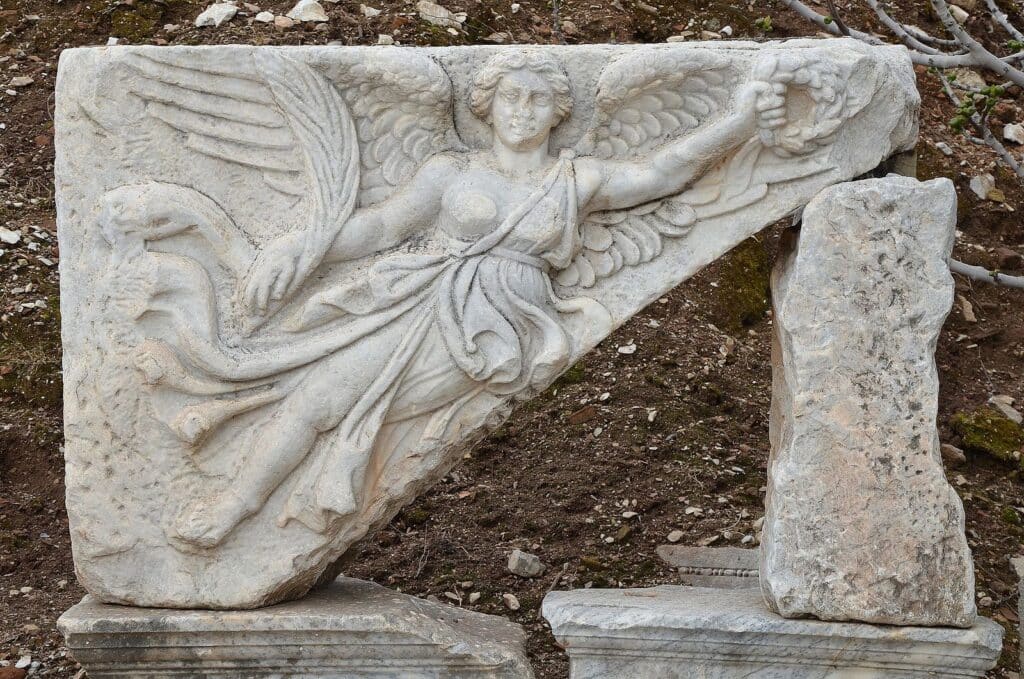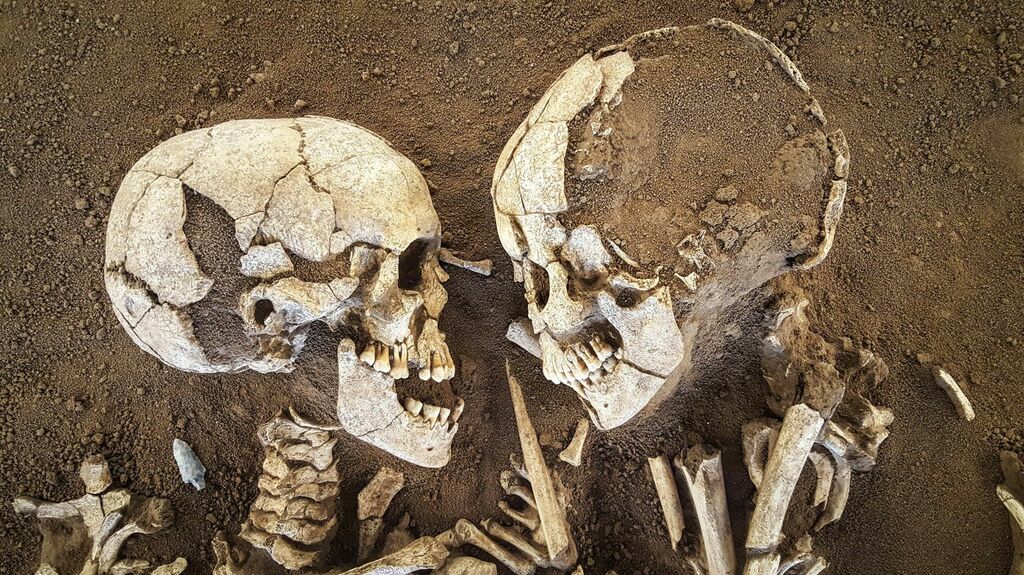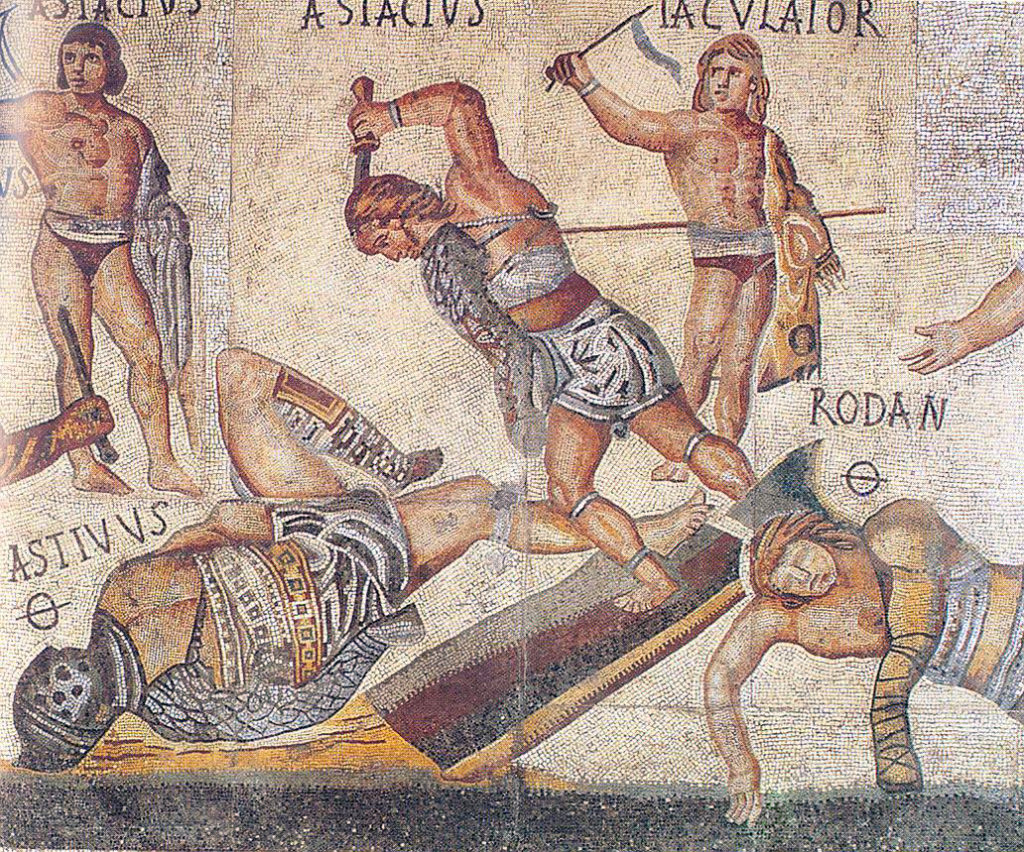In ancient Greece, Nike was worshiped as the goddess of victory. Her favor graced the victors of all kinds of contests, from foot races to great battles. She could also grant people success in the arts.
Nike was associated with both Zeus and Athena. She was often shown with huge wings on her back and golden sandals on her feet, carrying a laurel wreath or some other symbol of victory.

Mythology of the Goddess Nike
Nike was first mentioned in Hesiod’s Theogony, written around 700 BC. The earliest known statue of the goddess was crafted around 570 BC.
Nike was the goddess who presided over competitions. She judged the excellence of both mortals and gods, and she was associated with victorious athletes and successful artists.
In war, she was on the side of the victor. If victory was still uncertain and either side might triumph, she “day by day between them hovered on uncertain wings” as described in Ovid’s Metamorphoses. She was often shown in mid-flight, looking at the viewer as she rushed past.
Nike was born of the River Styx, goddess of the underworld. Styx was the eldest daughter of the Titan Oceanus. She married Pallas, another Titan. Together they had four children.
Nike’s three siblings were Bia, Kratos, and Zelus. Each one personified some concept. Bia represented force, Kratos represented strength and dominion, and Zelus represented rivalry or envy. Nike, the most well-known of the siblings, personified victory.
In some texts, such as the Homeric Hymns, Nike is the daughter of Ares, who was the god of war.
Nike was a contemporary of Zeus, and she supported him during the Titanomachy. During this War of the Gods, the Olympians fought to overthrow the Titans, who lived on Mount Othrys.
Zeus banded together with his siblings to depose their father, Cronus. The resulting war went on for ten years, and Nike was one of the first to offer Zeus her allegiance.
Ever after, Nike was closely associated with Zeus. Theogony says that Nike and her siblings did “not live apart from Zeus… nor go except where the god goes before them, but they sit forever beside heavy-booming Zeus.” The immense Statue of Zeus at Olympia built in 435 BC held an ivory and gold statue of the goddess Nike in his outstretched hand.
Following the Titanomachy, Nike also served Athena. The statue of Athena located in the Parthenon in Athens also held Victory in her hand; her other hand clutched a spear.
Nike and Athena
Athena was the goddess of wisdom and warfare. She was one of the Twelve Olympians, the most prominent and powerful gods and goddesses of Greek mythology. She sprang fully grown from the head of her father, Zeus, and became his favorite child.
In Dionysiaca, Athena sends Nike as her emissary to aid Zeus in his battle against a monstrous snake-headed giant towards the end of the War of the Titans. She appeared in the guise of his lover Leto, mother of the god Apollo and the goddess Artemis. She urged him to confront the monster and defend Olympus.
The other gods had given up and fled the battle. If Zeus did not gather his courage and his thunderbolts, Nike warned, the monstrous Typhon would destroy Olympus and enslave Zeus’s daughters Artemis and Athena.
The next day, Nike led Zeus into battle against the serpentine Typhon, who was led by Eris, the goddess of discord. Nike protected Zeus with her shield while he attacked Typhon with thunderbolts and freezing rain. Together they defeated the monster, and Zeus claimed victory over the Titans.
Nike is so closely associated with Athena that she is sometimes viewed as one aspect of the goddess: the victory brought by wisdom in battle. They are often depicted together, armed with spear and shield.
Some scholars believe that Nike originated as one of three aspects of Athena. The other two were Boulaia, who represented wisdom, and Ergane, who represented skilled handcraft.
Others think that the two were always separate. This is partially because Nike represents victory in athletic and musical competitions as well as war, while Athena’s dominion doesn’t extend to athletics or the arts.
The people of Athens worshiped the two goddesses as one deity called Athena Nike. The cult of Athena Nike was presided over by a priestess chosen democratically by the women of Athens.
The Acropolis of Athens, an ancient fortress located above modern-day Athens, had a temple devoted to both goddesses called the Temple of Athena Nike. A statue of the goddess, wingless to keep her in Athens, was featured in the parapet.

The temple was decorated with many elaborate friezes of battles. One intricate carving depicts the goddess fixing her sandal.
The Temple of Athena Nike was built around the year 420 BC. The cult of Athena Nike had already been active for over a century at that point, and the temple was built after the previous one was destroyed by invaders from Persia.
As ancient Greece gave way to the Macedonians and Alexander the Great, they accepted the goddess of Victory as their own. Some coins from that era show Alexander on one side and Nike on the other. She was a popular figure throughout the Hellenistic period and beyond.
The Roman Goddess Victoria
When Rome rose to power centuries later, they too adopted Nike as their own. In their religion, the goddess of victory was called Victoria.
Like Alexander had done many centuries before him, the Roman emperor Constantine II made coins with his face on one side and winged victory on the other.
Victoria was particularly popular with the military. In 294 BC a temple was constructed for the goddess on Rome’s centremost hill. It was used to store riches taken in battle.
Before long, there were many other shrines in her honor throughout Rome. Sacrifices were made to her at the Senate-house altar before each meeting.
Her altar was removed from its temple at the senate house by a Christian empire of Rome in the year 382.

